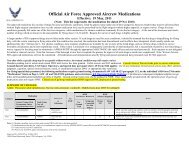Force Health Protection: Nutrition and Exercise Resource Manual
Force Health Protection: Nutrition and Exercise Resource Manual
Force Health Protection: Nutrition and Exercise Resource Manual
Create successful ePaper yourself
Turn your PDF publications into a flip-book with our unique Google optimized e-Paper software.
Open-Water Swimming<br />
Open-water swimming can be a very<br />
challenging <strong>and</strong> rewarding workout. But<br />
before heading out to sea, you should be able<br />
to swim at least one mile continuously, <strong>and</strong><br />
consistently, in a lap pool. When swimming in<br />
open water you are faced with many safety<br />
issues not addressed in pool training, so follow<br />
these safety rules:<br />
◆ Ask lifeguards or locals about the safety of the area. (Are there<br />
any strong currents or riptides? What marine life is in the area?<br />
Avoid areas where sharks have been spotted.)<br />
◆ Walk the beach along the course you will be swimming. Look at<br />
buoys, surfers, <strong>and</strong> other swimmers to gauge the direction <strong>and</strong><br />
strength of the current. Pick l<strong>and</strong>marks (houses or lifeguard<br />
stations) to use as markers while you are swimming.<br />
◆ Wear proper gear for open-water swimming, including: a<br />
comfortable, unrestricted suit (a wet suit in cold water); a swim<br />
cap; goggles with UVA/UVB protection; water gloves <strong>and</strong> fins.<br />
Use a waterproof sunscreen all over your body.<br />
◆ Never swim alone, especially in unfamiliar waters. Ask someone<br />
familiar with the waters to accompany you. On your first outing,<br />
swim just past the breaking waves. As you feel more comfortable,<br />
gradually move further out.<br />
◆ Follow the shoreline as your primary guide, staying 100 to 150<br />
yards outside the breaking waves. Check your distance from the<br />
shoreline as you turn your head to breathe. Swim toward an<br />
unmoving target in the distance so you do not get off course.<br />
Check your position with this target every 50 to 100 yards <strong>and</strong><br />
adjust your course appropriately.<br />
◆ A good starting distance for open-water swimming is a half mile.<br />
Use your l<strong>and</strong>marks to judge your distance. Swim against the<br />
current for the first quarter mile, then turn around <strong>and</strong> swim<br />
with the current for the last quarter mile. As you become<br />
comfortable swimming in open-water, gradually build up your<br />
distance by quarter mile increments.<br />
◆ Avoid boats <strong>and</strong> jet skis by wearing a brightly colored suit <strong>and</strong><br />
cap. If a boat is moving toward you, swim away from it <strong>and</strong> kick<br />
hard, making large splashes that announce your presence.<br />
Section adapted from L. Cox. Seaworthy. Women’s Sports <strong>and</strong> Fitness July-August 1995;17(5):73-75.<br />
54 <strong>Force</strong> <strong>Health</strong> <strong>Protection</strong>:






![Body Composition and Military [PDF] - Human Performance ...](https://img.yumpu.com/43269347/1/190x245/body-composition-and-military-pdf-human-performance-.jpg?quality=85)
![Tips for Grocery Shopping [PDF]](https://img.yumpu.com/37447379/1/190x245/tips-for-grocery-shopping-pdf.jpg?quality=85)



![Synthetic Drugs [PDF] - Human Performance Resource Center](https://img.yumpu.com/37447322/1/190x245/synthetic-drugs-pdf-human-performance-resource-center.jpg?quality=85)


